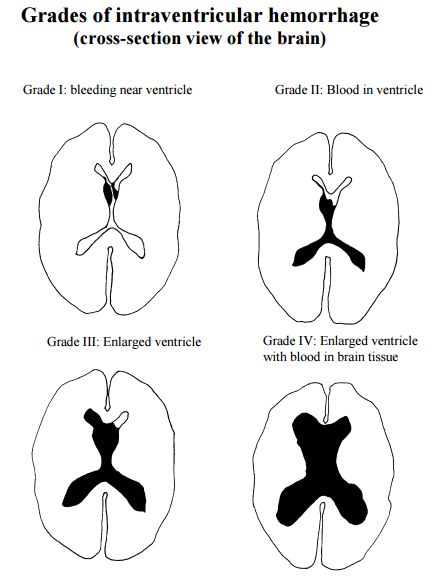Intraventricular hemorrhage in premature babies
What is intraventricular hemorrhage (IVH)?
The ventricles (ven-trih-kuhls) are spaces in the brain that contain cerebrospinal fluid. Intraventricular hemorrhage (in-trah-ven-trik-yu-lar hem-or-age) is bleeding in or near the ventricles. It is sometimes called a "bleed".
What causes IVH?
A preterm baby's brain has many tiny, fragile blood vessels. After birth, the premature baby's brain is exposed to changes in blood flow and oxygen levels. This may cause the blood vessels to break and bleeding to occur. It happens mostly in babies who are extremely premature or who have medical problems during or after birth.
What are the signs of IVH?
Many babies do not have any symptoms at the time the bleeding occurs. Some babies do have symptoms such as:
- apnea (pauses in breathing)
- bradycardia (low heart rate)
- anemia
- seizures
- poor muscle tone
- decreased activity
- bulging fontanel (the soft spot on the top of the baby's head)
How is IVH diagnosed?
Babies at risk for IVH will have an ultrasound of the head to check for bleeding in the first days after birth. This test is done at the baby's bedside and uses sound waves to give a picture of the baby's brain. The picture will show the size of the ventricles and any areas of bleeding in the brain tissue.
IVH is graded on a scale of one to four, with grade IV being most severe. See pictures below.
What happens to babies who have an IVH?
As many as 30% of babies born weighing less than 1,000 grams (about 2 pounds, 4 ounces) have intraventricular hemorrhages. Most of these bleeds are mild (Grade I or II), and about 90% resolve with few or no problems. In mild cases, the body absorbs the blood. Usually the follow-up head ultrasound is normal. The baby's development is most often typical for a preterm baby.
In more severe bleeds (Grade III or IV), as blood absorbs there can be damage to the brain tissue. These bleeds (especially Grade IV) may result in more problems. Short-term problems include enlarged ventricles and hydrocephalus. (See the education sheet "Hydrocephalus.")
Long-term problems include cerebral palsy (spasticity), hearing loss, vision problems and learning disabilities.
How will I know if my baby will have long-term problems?
This can only be determined over time by monitoring the baby's development. For this reason, it is important to have your baby’s progress followed after discharge from the hospital.

Questions?
This sheet is not specific to your child but provides general information. If you have any questions, please ask the doctor.
Children's Hospitals and Clinics of Minnesota
Patient/Family Education
2525 Chicago Avenue South
Minneapolis, MN 55404
Last reviewed 7/2015 © Copyright
This page is not specific to your child, but provides general information on the topic above. If you have any questions, please call your clinic. For more reading material about this and other health topics, please call or visit Children's Minnesota Family Resource Center library, or visit www.childrensmn.org/educationmaterials.
© 2024 Children's Minnesota
